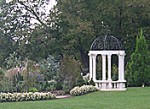 For weeks I complained about the lack of rain and finally it rained; now I am complaining about too much rain. The soil is soupy, there is standing water in low areas, the grass is developing brown spots, the squash are drowning, and pests are multiplying like wild fire. I can’t believe we are having this much rain in mid July, a time that is traditionally fairly dry. The bright side is that the temperatures have been tolerable and there has been plenty of sunshine as the rain has come in torrential showers, especially in the evenings (how the blackspot fungus must be rejoicing!).
For weeks I complained about the lack of rain and finally it rained; now I am complaining about too much rain. The soil is soupy, there is standing water in low areas, the grass is developing brown spots, the squash are drowning, and pests are multiplying like wild fire. I can’t believe we are having this much rain in mid July, a time that is traditionally fairly dry. The bright side is that the temperatures have been tolerable and there has been plenty of sunshine as the rain has come in torrential showers, especially in the evenings (how the blackspot fungus must be rejoicing!).
Speaking of black spot; we have two different kinds of climbing roses growing side by side on an arbor. One of them, ‘New Dawn’ is an Earthkind rose which means that after the first year you don’t have to do much for it. Since it is disease resistant it needs no spraying and we never spray it. Here are the leaves: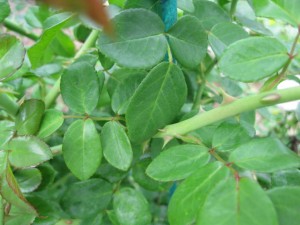
Did you notice that there is not a single spot of black spot? Not a single spot! Now take a look at ‘Bantry Bay’. We spray it ever 10 days; it grows in the same soil as ‘New Dawn’, gets the same amount of water, same fertilizer, same deadheading. I hate to think what the Green Rose leaves would look like if we didn’t spray.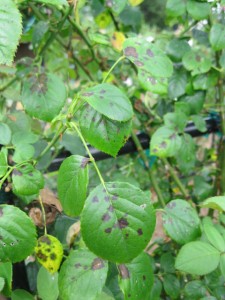
To be entirely fair, although ‘Bantry Bay’ gets black spot, it doesn’t seem to slow it down any. It is a vigorous grower, marching up the arbor a head of the others by a long shot. And while it is on her way up the arbor it manages to bloom without stopping, a unusual characteristic for a climbing rose. So, I guess it is well worth the spray job and tolerating the disfigured leaves.
The two stars of the rose garden this week are both green. The first one, the ‘ Green Rose’ has flowers that don’t look like roses or even flowers, for that matter. That’s why I grow it, can’t resist an odd looking flower like this.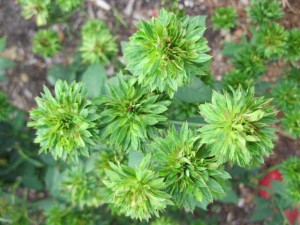
The bush is not so great looking this year. It is a China rose and a bit on the tender side in a cold winter so it took a beating this past year.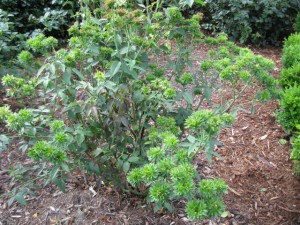
The other green rose is ‘Greensleeves’, a floribunda rose, producing its flowers in clusters.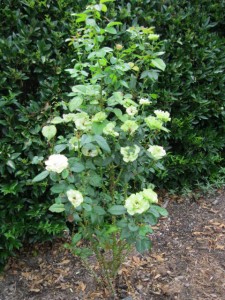
The flowers open a pale peach but turn to chartreuse green as they mature on the bush. Flower arrangers love them for the green color but I find that the dirty looking mature stamens are a big negative. Also, the Japanese beetles love the flowers and ruin a large number of the flowers before they turn green. Still, I rather like this one and would be sad to see it die.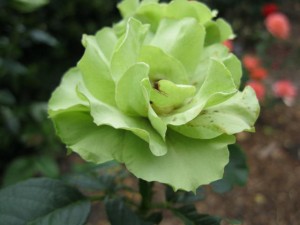
The Kordes rose ‘Dortmund’ is a big guy and is not reblooming but is producing huge hips on the branches I could not reach to deadhead. This rose is in a European group equivalent to our Earthkind roses and needs no pampering. I walk on by it when spraying and have never seen any significant fungus on it. A very good rose!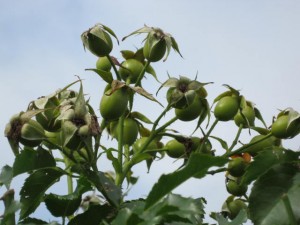
We have an ugly corner in the rose garden that contains the air conditioning units a numerous pipes. We try to hide the pipes with a big rose bush but thought that a vine might be nice there too. The head gardener got busy last fall and made a large arbor to go up against the wall of the house and over the bathroom window.
I started moonvines from seed and they are just beginning to take hold and climb up the arbor. Once they get going they will proceed quickly and make a good showing but they have been taking their time getting established this year. I think I will start them many weeks earlier than I did this year so that they will make it to the top and bloom before frost.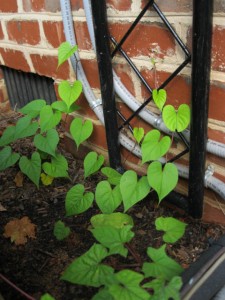
The cardinal vines seeds are started at the same time as the moonvines and have been growing well. They are at the top of their support, another project completed recently by the headgardener (he does a lot of welding!). Two seedlings were planted in each pot and they have both done well but their delicate nature makes them somewhat inconspicuous thus far.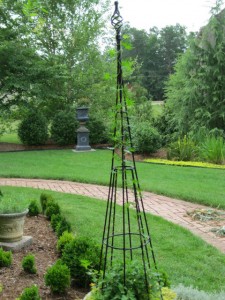
I started the sunflower vine seeds later than the other two and they are consequently less mature than the other two but finally taking grip this week. Their support is like the ones the cardinal vines are growing on but much, much larger. Verbena “Homestead Purple grows around them.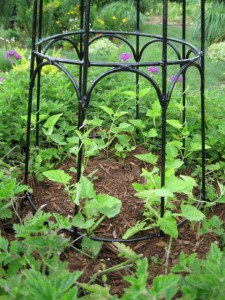
The star of the formal garden is the black eyed Susan, Rudbeckia “Goldsturm’.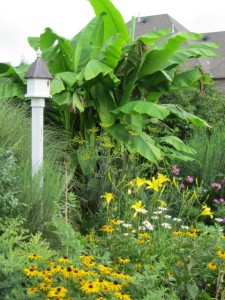
Its golden yellow color is perfect with the daylily “Stella D’oro.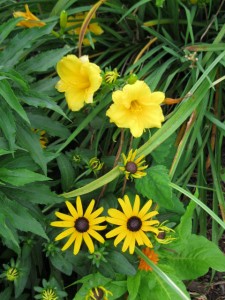
The shasta daisy ‘Becky’ echos the shape of rudbeckia and picks up the color in its center.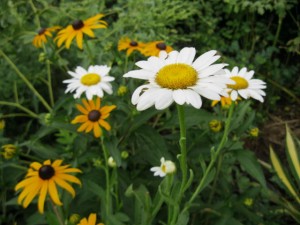
I also like it with the pink cone flowers although golden yellow and dusty pink are not really a combination favor otherwise.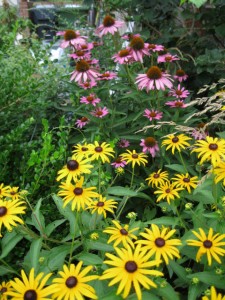
The pink coneflower is a knockout, however, with the opening flowers of Joe Pye weed ‘Little Joe’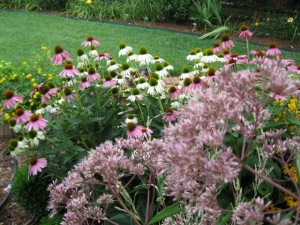
I had some fun with the pink coneflower this week. I had to cut some back so I picked up a stem with three flowers and marched around the garden trying it with various other flowers to see what nice combinations I might put together for next year with all the extra pink coneflowers I seem to have. One of my favorite combos was with globe thistle.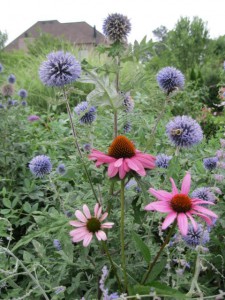
Another combo I liked was with liatris. Both are floppy in my formal garden this year so I don’t know that I would want to put them together; but they look nice.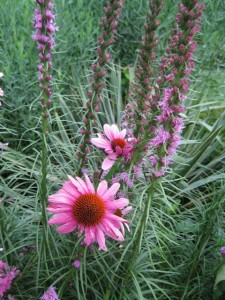
The color combination of the coneflower and verbena was eye catching but the difference in height made this one unrealistic.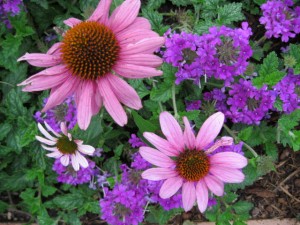
The yellow swallowtails have moved on to the lantana this week. The black ones are gone (sigh).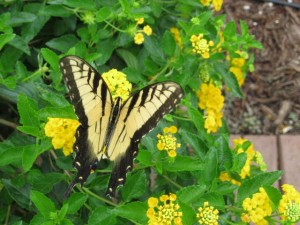
A lone common buckeye found the yellow scabiosa clump and was quite obliging while I snapped his picture.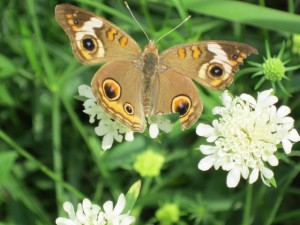
The magnolia ‘Little Gem’ is doing a rebloom. I especially love the brown undersides of the leaves.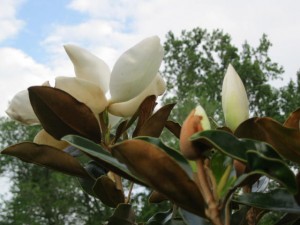
The rose colored crepe myrtle didn’t last very long this year but added a lot of color to the rose garden where it is planted outside the surrounding ligustrum hedge.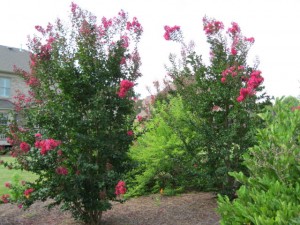
The flower trusses are heavy and full but unfortunately already producing fruit.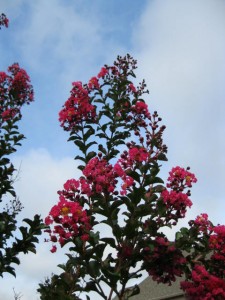
Yup, we harvested eggplant this week and I made eggplant parmasan. There are plenty more coming along so I will probably make lots more.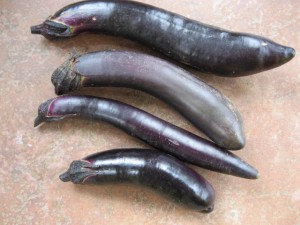
The acorn squash have been rolling in also. I am not used to having them so early but now that we have begun grilling them I welcome them.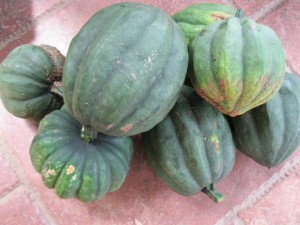
Some are not as ripe as I would normally like but some animal, probably squirrels, have been dinning on them lately so I have been harvesting them as soon as I think they are edible.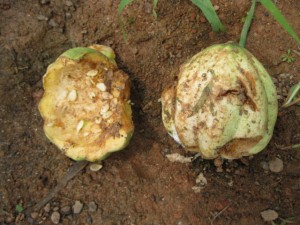
The summer squash are coming in my the armloads with no end in sight.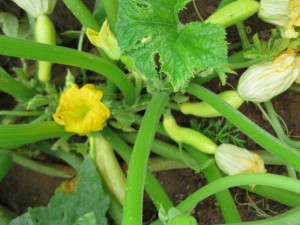
But the zucchini, growing in the next row over, are being destroyed by squash vine borers.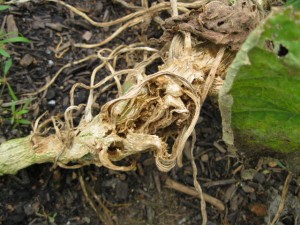
I saw damaged leaves on the beans;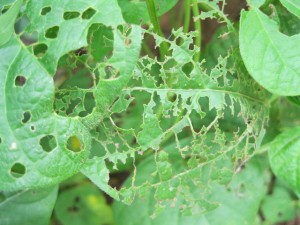
Sure enough, those wretched Mexican bean beetles have arrived.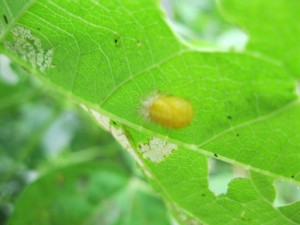
Meanwhile the pepper plants are being routinely chomped by the deeer.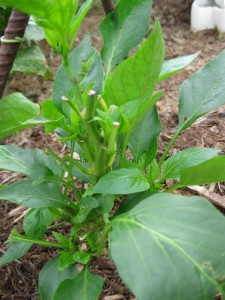
We have put up tripods of metal stakes around them hoping that this will cause them to move out of the area without any more damage.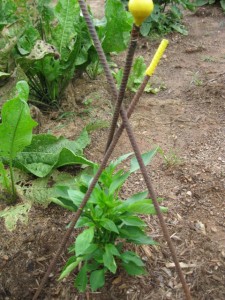
I am also saving cat hair every time I groom my Siamese cats, Horace and Clodia; it is going to be a long time until I have enough hair to do anything significant but meanwhile I will have the best groomed cats in town. Last year I got so desperate when the deer were eating the roses that I spread used kitty litter around the perimeter of the rose garden. Somehow I can’t quite bring myself to put kitty litter in the vegetable garden so I hope the tripods or hair will work. There is no sure way of ridding a garden of deer so I have to do the best I can and live with the results.

Do the green roses have a perfume?
Jackie,
Sad to say, they have none.
Karen